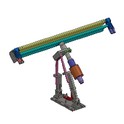Hey there! As a supplier of universal ultrasonic transducers, I often get asked about how to install these nifty devices. In this blog post, I'm gonna walk you through the whole process, step by step.
First off, let's talk a bit about what a universal ultrasonic transducer is. Simply put, it's a device that can convert electrical energy into ultrasonic waves and vice versa. These transducers are used in a wide range of applications, from industrial cleaning to medical imaging. You can learn more about them on our website Ultrasonic Transducer.
Before You Start
Before you even think about installing the transducer, there are a few things you need to do.
1. Gather Your Tools
You'll need a set of basic tools for the installation. This usually includes a screwdriver, a wrench, and some measuring tape. Make sure all your tools are in good working condition.
2. Read the Manual
I know, reading manuals isn't the most exciting thing in the world, but it's super important. The manual that comes with your universal ultrasonic transducer will have all the specific instructions for your model. It'll tell you things like the correct mounting position, the recommended torque for the screws, and any special precautions you need to take.
3. Check the Installation Site
Take a good look at the place where you're gonna install the transducer. It should be clean, dry, and free from any debris. The surface should also be flat and stable to ensure proper operation. If the site is outdoors, make sure it's protected from the elements.
Step 1: Mounting the Transducer
The first step in the installation process is to mount the transducer.
1. Choose the Right Location
The location of the transducer is crucial for its performance. It should be placed in an area where it can effectively transmit and receive ultrasonic waves. For example, if you're using it for a cleaning application, it should be positioned close to the object being cleaned.
2. Mark the Mounting Holes
Once you've decided on the location, use a pencil or a marker to mark the positions of the mounting holes on the surface. Make sure the marks are accurate, as any errors could lead to a poor installation.
3. Drill the Holes
Using a drill bit of the appropriate size, drill holes at the marked positions. Be careful not to drill too deep or too shallow. You can refer to the manual for the recommended hole depth.
4. Secure the Transducer
Place the transducer over the holes and insert the screws. Use a screwdriver or a wrench to tighten the screws, but don't over-tighten them. Over-tightening can damage the transducer or the mounting surface.
Step 2: Electrical Connections
After mounting the transducer, it's time to make the electrical connections.
1. Identify the Wires
The transducer will have a set of wires coming out of it. These wires are usually color-coded to make it easier to identify them. The manual will tell you which wire is for power, which is for the signal, and so on.
2. Connect the Wires
Carefully connect the wires to the appropriate terminals on the power supply and the control unit. Make sure the connections are secure and there are no loose wires. You can use wire connectors or soldering to make the connections, depending on your preference.
3. Insulate the Connections
Once the connections are made, use electrical tape or heat shrink tubing to insulate them. This will prevent any short circuits and ensure the safety of the installation.
Step 3: Testing the Transducer
After the installation and electrical connections are complete, it's time to test the transducer.
1. Power On the System
Turn on the power supply and the control unit. Make sure all the indicators are working properly.
2. Check for Operation
Use a suitable testing device to check if the transducer is working. You can look for signs of ultrasonic waves, such as vibrations or changes in the environment. If the transducer isn't working, double-check all the connections and make sure the installation is correct.
3. Adjust the Settings
If necessary, adjust the settings on the control unit to optimize the performance of the transducer. This may include adjusting the frequency, the power level, or the sensitivity.
Troubleshooting
Even if you follow all the steps correctly, you may still encounter some problems during the installation or operation of the transducer. Here are some common issues and their solutions:
1. No Signal
If the transducer isn't producing any signal, check the electrical connections first. Make sure the wires are properly connected and there are no loose or damaged wires. You may also need to check the power supply and the control unit to ensure they're working correctly.
2. Poor Performance
If the transducer is working but the performance is poor, it could be due to a number of factors. Check the mounting position to make sure it's correct. You may also need to adjust the settings on the control unit to optimize the performance.
3. Overheating
If the transducer is overheating, it could be a sign of a problem with the power supply or the electrical connections. Check the power level and make sure it's within the recommended range. You may also need to check for any short circuits or loose connections.

Conclusion
Installing a universal ultrasonic transducer isn't too difficult if you follow the right steps. By gathering the right tools, reading the manual, and taking your time, you can ensure a successful installation. If you have any questions or need further assistance, don't hesitate to contact us. We're here to help you get the most out of your ultrasonic transducer.
If you're interested in purchasing a universal ultrasonic transducer or have any questions about our products, feel free to reach out to us for a procurement discussion. We'll be more than happy to assist you!
References
- Manufacturer's Manual for Universal Ultrasonic Transducer
- Industry Standards for Ultrasonic Transducer Installation






